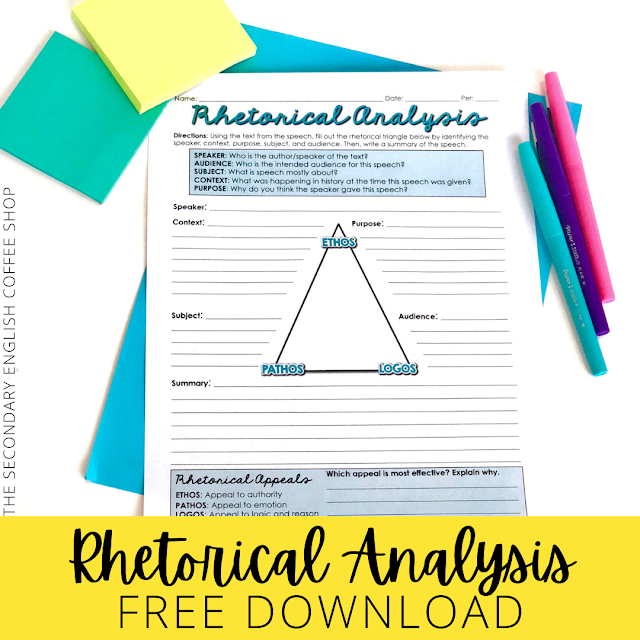One of my favorite units to teach in my classroom is rhetorical analysis because students learn the power, beauty, and effectiveness of language. When teaching rhetorical analysis, we teach our students to analyze how the author writes rather than simply looking at what the author writes. We teach our students to look at the author’s effectiveness. We teach our students to look at which strategies an author uses and why those particular strategies are so effective.
Teaching our students about rhetorical analysis helps them not only in the classroom setting but also in the real world. Knowing how and why people, corporations, and advertisements can effectively convince and persuade people to take actions, purchase goods, or hold certain values and beliefs play a critical role in informed decision-making skills.
And while it may sound like teaching rhetorical analysis might be a bit dry and mundane, that could not be further from the truth. Teaching rhetoric and rhetorical analysis can be both exciting and entertaining.
Getting Started with Rhetorical Analysis
When I introduce rhetorical analysis to my students for the first time, I always start with direct instruction and I use this rhetorical analysis unit to introduce the content. By introducing and teaching students about rhetorical analysis, rhetorical appeals, and rhetorical devices, they become familiar with the subject. Furthermore, providing students with examples helps them grasp the concept.
 |
| Rhetorical Analysis with Sticky Notes Teaching Unit |
Once students have a basic understanding, I then teach modeled annotation and analysis. I teach students how to annotate text, and as we class, we annotate the same text together. To help students gain confidence in their annotation and rhetorical analysis skills, I first have students annotate with me as a whole class. Once they branch out, I have them annotate in pairs and share their annotations with another group and then with the class. By practicing annotations in this scaffolded way, students learn how to annotate the text and identify rhetorical devices and appeals in a manner that helps them build confidence in their skills.
Rhetorical Analysis Student Practice
Once students have a basic understanding of rhetoric and rhetorical analysis, I move on to independent practice. By doing so, I can use small classroom assignments and activities as formative assessments to gauge student understanding.
One way to move toward independence is to ask your students rhetorical analysis questions that get your students thinking critically. In a blog post, I've compiled these 15 rhetorical analysis questions to use when analyzing a text.
Another way that you can have students move toward understanding and independence is by having them complete a rhetorical triangle analysis of your selected text. In doing so, students demonstrate their understanding of the text. You can download a free rhetorical organizer HERE!
Engaging and Fun Rhetorical Analysis Activities
Toward the end of my rhetorical analysis unit, I incorporate more fun and engaging activities that allow students to demonstrate their understanding. In a previous blog post, I share my favorite historical and political speeches that are excellent for a rhetorical analysis unit.COMMERCIALS
When analyzing rhetoric, my students love watching commercials to see which appeals and devices companies use as marketing strategies. Since commercials are usually thirty seconds to a minute in length, this makes a great warm-up activity. I like to show a commercial right after the bell rings at the start of class, ask students to identify which devices and appeals they find, and explain why those devices and appeals are effective.
GROUPS ANALYSIS POSTERS
A couple of years ago I had my students complete collaborative rhetorical analysis poster projects. Each group of three to four students received a different political or historical speech to analyze. Students read, annotated, and analyzed the text. Then, they identified various appeals and strategies that the speaker used and wrote a summary of the speech. This project took two fifty-five-minute class periods to complete.
I wrote more about this project on my website: Collaborative Rhetorical Analysis Poster Project.
ARTISTIC PAPA SQUARES
Another one of my favorite rhetorical analysis projects is the artistic PAPA square. PAPA is an acronym that stands for Purpose, Argument, Persona, and Audience. Using this acronym for rhetorical analysis, students create an artistic square that has two requirements: visually, it resembles the topic; and it also analyzes the text for its use of appeals and devices.
Usually, I have my students complete this project for one of their sources during our big research unit. You can read more about this project and sign-up to receive a free assignment handout on my website: Artistic PAPA Square.
Usually, I have my students complete this project for one of their sources during our big research unit. You can read more about this project and sign-up to receive a free assignment handout on my website: Artistic PAPA Square.
Here are some more amazing resources and teaching tips for rhetorical analysis:
Persuasion Techniques Bell Ringers by Nouvelle ELA
Persuasive Essay Writing: Snowball Collaborative Activity by Presto Plans
Real Life Persuasion Lessons and Activities by Room 213
Persuasion Techniques Bell Ringers by Nouvelle ELA
Persuasive Essay Writing: Snowball Collaborative Activity by Presto Plans
Real Life Persuasion Lessons and Activities by Room 213




















